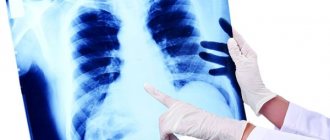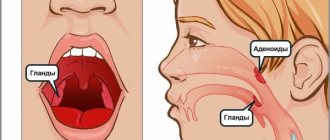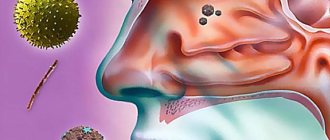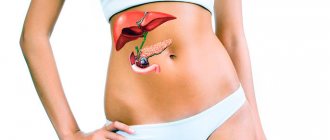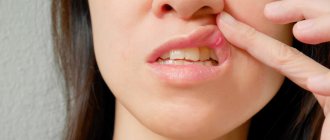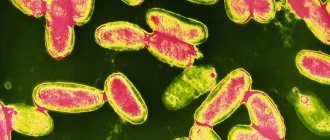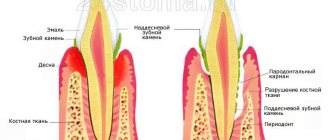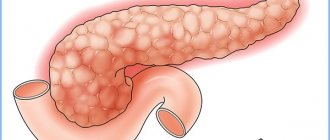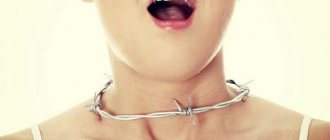Frontitis is an inflammation of the mucous membranes of the upper sinuses, located in the lower part of the forehead. It manifests itself as general weakness and headache, does not have pronounced symptoms, and often develops into a latent chronic form with periods of exacerbations.
The accumulation of purulent discharge near the eyes and brain can lead to serious complications, including death, so the disease must be promptly identified and treated. To do this, it is important to contact an otolaryngologist in a timely manner.
How to treat frontal sinusitis with antibiotics
Targeting the bacterial infection is the basis of therapy. Antibacterial drugs are presented in a wide range; it is necessary to choose the most effective ones in each specific case.
The best option is to inoculate the separated frontal sinus on a nutrient medium and then determine the sensitivity of the pathogen to antibiotics. This method will give results within 24 hours and will avoid the prescription of ineffective drugs.
But in practice, in medical institutions it is often not possible to carry out such a study at all in the first days of illness. Or the material is collected, but sent to distant laboratories.
Therefore, the medical tactics are as follows: the first course is prescribed a broad-spectrum antibiotic; if recovery does not occur, then a narrow-spectrum antibiotic is used in the second course (upon receipt of results from the laboratory, a strictly defined drug is prescribed).
Antibiotics for frontal sinusitis, prescribed in the first course, also take into account the fact that most often the disease is caused by Haemophilus influenzae or pneumococcus. Therefore, among the broad-spectrum agents, preference is given to the penicillin group, macrolides and cephalosporins.
Of the penicillins, amoxicillin derivatives (Amoxiclav, Augmentin, Doxycycline) are most often used in the form of tablets or injections, the dosage is calculated depending on the patient’s weight.
Of the latest generation cephalosporin antibiotics, Cefaclor, Cefotaxime, and Ceftriaxone are prescribed.
Drugs from the macrolide group can be used not only as the first course, but also as the second, if penicillin or cephalosporin antibiotics are ineffective. An example of macrolides is Sumamed, which contains azithromycin.
It has a bactericidal effect on streptococci, pneumococci, Haemophilus influenzae, fusobacteria, clostridia, and some protozoa. The drug is used for intramuscular or intravenous administration.
There are antibacterial agents for topical use. This is a nasal spray Bioparox containing fusafungin, which is very effective for acute and chronic sinusitis, as well as Isofra and the combined drug Polydex (a complex with a vasoconstrictor and hormonal component).
Symptomatic treatment of frontal sinusitis
Etiological therapy should be supplemented with symptomatic treatment. To reduce swelling of the mucous membrane, vasoconstrictors (vasoconstrictors) are needed for topical use.
Their selection, dosage and course duration must be made by a doctor, since any violation can lead to damage to the epithelium.
The drug is selected from the short-, medium- or long-acting groups. Examples:
- Galazolin
- Nazol
- Rhinostop
- Nazivin
- Polydexa is very effective.
Treatment of frontal sinusitis can be carried out using homeopathy remedies, for example, Sinuforte. This drug, produced on the basis of the active substances of cyclamen, is an absolutely natural herbal medicine. Sinuforte, like Echinacea, Traumeel or Engystol, has a complex effect (antimicrobial, vasoconstrictor and immunomodulatory).
The most important direction of therapy is hot or cold inhalations and rinsing the sinuses with special solutions. This can be easily done at home, but it must be remembered that the procedures are not carried out at elevated body temperatures. To reduce it, you can use antipyretics based on Paracetamol.
Inhalations are carried out both through a nebulizer and with the help of ordinary hot infusions (chamomile, calendula, boiled potatoes, sage). Rinsing is carried out using a saline solution (2 teaspoons of salt per 2 liters of water) or pharmaceutical preparations
- Dolphin
- Aqua Maris
- Marimer
- Physiometer
- Otrivin Sea
- Quicks
In a medical facility, the “cuckoo” procedure is performed, or the supply of a solution under pressure through one nostril and the removal of rinsing water through the other. At the same time, drainage and cleansing of all paranasal sinuses occurs. The use of the YAMIK sinus catheter is also very effective, which allows you not only to clean the frontal sinuses, but also to treat them with medicinal solutions.
Frontitis is a pathology that is dangerous due to the development of serious complications. Therefore, treatment of the disease must be comprehensive and started in a timely manner.
Nasal drops
You can make your own nasal drops. They are used when diagnosing “chronic frontal sinusitis”, treatment of which at home is considered optimal. There are several proven recipes:
- Black radish juice is used to “puncture” the nose, which allows you to quickly restore normal breathing.
- Kalanchoe leaves. They are placed in the refrigerator for 3 days. After this, they are washed, finely chopped and the juice is collected. The latter is diluted in water in a ratio of 1:2 (1 part juice, 2 parts water).
- Propolis. It needs to be frozen and then crushed (50 g). After this, you need to add 10 g of olive oil and leave for 3 days in a dark container.
Such drops should be instilled only after inhalation and rinsing. However, this cannot replace traditional treatment, because frontal sinusitis develops quite quickly, and folk remedies are not always able to eliminate the cause of the disease.
Frontitis treatment
How to treat frontal sinusitis will depend primarily on the form of the disease (acute or chronic), as well as the nature of the inflammatory process (serous, purulent or polypous).
It is also important to understand the cause of inflammation (allergies, viruses, bacteria, fungi), because the list of prescribed drugs and procedures will depend on this.
That is, if you do not want frontal sinusitis to develop into a chronic purulent form due to improper treatment, which requires mandatory surgical intervention, consult an ENT doctor from the very beginning. The doctor will examine you, refer you for examinations if necessary, and then you can calmly take pills and put drops into your nose at home.
Treatment of acute sinusitis
Acute frontal sinusitis that occurs against the background of ARVI and influenza, or allergic rhinitis, can be completely cured with anti-inflammatory drugs based on ibuprofen, which will relieve pain and reduce inflammation. And also with special drops in the nose - to create an outflow of mucus and inflammatory secretions from the sinuses into the nasal cavity.
Those. the most important thing in treatment is to create a good outflow of exudate and mucus from the sinuses into the nasal cavity. Most symptoms of acute sinusitis begin to disappear within a few days of treatment, but you must complete the entire course of treatment prescribed by your doctor.
Drops to relieve nasal congestion - keep in mind that traditional vasoconstrictor drops for a runny nose cannot be used for sinus inflammation for more than 2-3 days. This is due to the fact that after this period they begin to have the opposite effects (due to addiction) and worsen the condition of the mucous membrane. To relieve nasal congestion during frontal sinusitis, it is optimal to use the following drugs:
- Spray "Rinofluimucil" (Italy, costs about 250 rubles) - the spray consists of two active components, one of which reduces the secretion of mucus and pus, and also facilitates their discharge, and the second - relieves swelling from the nasal mucosa. This spray will go well with medications (such as Sinupret, Sinuforte) that stimulate the removal of inflammatory exudate from the sinuses.
- Spray "Nasonex" (Belgium, from 500 rubles) - the active component is a low dosage of glucocorticoids. It perfectly relieves nasal congestion, and it can be used for a long time (in courses of 2-3 months), which is important for chronic inflammation of the sinuses, nasal passages, and allergic rhinitis. This drug will also work well with sinus mucus stimulants (Sinupret or Sinuforte).
Preparations to stimulate the release of mucus from the sinuses - these drugs can be in the form of drops or tablets. They consist entirely of herbal ingredients, which should be pleasant for people looking for traditional methods of treatment. Let us say right away that such drugs can only be an auxiliary means of therapy, but not the main method of treatment.
The herbal components of the following drugs cause increased function of the ciliated epithelium of the mucous membrane (so to speak, cilia), which promotes the removal of mucus and exudate from the sinuses into the nasal cavity through small openings between them.
- The drug "Sinupret" (Germany) is available in the form of drops and tablets. Contains extracts of medicinal herbs that have an anti-inflammatory effect, as well as facilitating the removal of mucus and inflammatory exudate from the sinuses. Cost from 350 rub.
- The drug "Sinuforte" (Spain) - release form - in the form of nasal drops. Made from a medicinal plant extract. like the previous drug, it also helps remove mucus and inflammatory exudate from the sinuses. The cost is about 2300 rubles.
Antibiotics for sinusitis
As we wrote above: acute frontal sinusitis most often develops against the background of acute respiratory viral infections and influenza, and antibiotics, as is known, do not act on viruses. Taking antibiotics for acute frontal sinusitis only makes sense if a bacterial infection occurs and purulent inflammation develops, but this does not happen immediately.
Frontitis complications and consequences of the disease.
In the absence of complete treatment of the acute inflammatory process, chronic frontal sinusitis develops.
If even after this the patient does not take any action, the disease can cause very unpleasant consequences.
Possible complications after frontal sinusitis include:
- meningitis;
- other sinusitis;
- otitis;
- phlegmon of the orbit;
- swelling of the eyelids;
- sepsis;
- neurological disorders, in particular pathologies of the facial nerves;
- brain abscess, etc.
to the content?
Therapy
Treatment of frontal sinuses can take place both on an outpatient basis and in a hospital setting. It all depends on the severity of the patient’s condition. Sometimes, in particularly complex and advanced cases, it is necessary to resort to surgical intervention. In such situations, punctures are used to remove the contents of the sinuses. If there is a high density of mucus in the sinuses and it is impossible to remove it with the help of a puncture, more serious surgical intervention is resorted to. In most cases, frontal sinusitis can be treated without a puncture. Medicines, physiotherapy, homeopathy, rinsing, folk remedies, massage for frontal sinusitis are not all methods of treatment.
Treatment of frontal sinusitis in adults begins with the use of vasoconstrictor drugs to relieve swelling from the mucous membrane of the anastomosis, sinus and nasal cavity. Hormonal medications may be prescribed to reduce inflammation. For bacterial frontal sinusitis, antibiotics are prescribed, both local (in drops, sprays) and general.
Frontal sinusitis, like other sinusitis, can be cured by using the homeopathic drug “Sinupret”.
Treatment at home quickly is only possible if you strictly follow the doctor’s recommendations and prescriptions.
Diagnosis of frontal sinusitis makes it possible to determine the range of pharmacological drugs necessary for treatment. Carrying out a series of manipulations at the final stage of the disease (physiotherapy) is an excellent prevention of frontal sinusitis.
Antibacterial therapy
When pathogenic bacteria are detected in laboratory tests, antibacterial therapy must be started immediately and carried out in a full course without interruptions or premature withdrawal, even with a significant improvement in the patient’s condition. If the disease is not advanced, you can, on the recommendation of a doctor, limit yourself to only drops and sprays containing an antibiotic:
- "Tsiprolet";
- "Normax".
For high fever and headaches, tablets or injections of drugs such as:
- "Ceftriaxone";
- "Cefatoxime";
- "Ciprofloxacin";
- "Lincomycin."
In parallel with the course of antibiotics, antifungal drugs and probiotics are prescribed (to restore the intestinal microflora).
Vasoconstrictors
Vasoconstrictor drugs should be used only when necessary and as prescribed by a doctor. Uncontrolled use of drugs in this group is fraught with unpleasant consequences - atrophy of the mucous membrane, the occurrence of vasomotor rhinitis.
The list of vasoconstrictor drugs used for frontal sinuses is extensive. Here are the old drugs “Galazolin” and “Naphthyzin” and more modern ones:
- "Sanorin";
- "Nazivin";
- "Otrivin";
- "Nazol";
- "Rinazolin".
Vasoconstrictor drops are selected by the doctor for different durations of action - from 4-6 hours (short duration), to 6-10 hours (medium duration) and more than 10 hours - long-term.
Proper instillation is of great importance for successful treatment. The nose is instilled while lying down. The right nostril is closed when the head is tilted to the right side, the left - to the left. After instillation of the first nostril, you must not change your position for 10 minutes so that the drops reach their destination and do not flow down the back wall of the larynx. Only after this the other nostril is buried.
Nasal rinsing
Vacuum nasal rinsing is a very effective treatment for frontal sinusitis. This procedure is called “cuckoo” and consists of pumping a rinsing solution into one nostril and simultaneously withdrawing it from the other nostril. During the procedure, the syllables “ku-ku” are repeated, which makes it possible to block the communication between the nose and pharynx. At this moment, the solution enters the sinuses, washes out the pathogenic contents and exits. Anti-inflammatory and antibacterial drugs are added to the rinsing solution.
Inhalations
Inhalations must be carried out with great caution. The presence of pus in the sinuses and elevated body temperature are contraindications for inhalation.
It is advisable to carry out inhalations at the initial stages of the disease, if there is inflammation, but there is no purulent discharge, or at the final stages of follow-up treatment.
To prepare infusions for inhalation, both medicinal herbs are used, such as chamomile, sage, and essential oils, bay leaves; you can use “Zvezdochka” balm in small quantities.
have a mild and long-lasting effect not only on the frontal sinuses, but also on other parts of the respiratory tract.
Possible complications
Frontal sinusitis, like other types of sinusitis, must be treated. Lack of timely and correct therapy, as well as interruption of the course of treatment lead to consequences such as:
- Spread of infection to nearby sinuses. As a result, sphenoiditis, ethmoiditis, and sinusitis may develop.
- Transition of inflammation to the orbit and periorbital areas (abscess of the eyelids, phlegmon).
- Spread of pus into the brain (causing abscesses and meningitis).
Sepsis sometimes occurs against the background of frontal sinusitis, which can be fatal.
Symptoms of frontal sinusitis in adults
Depending on the severity of the inflammatory process, acute frontal sinusitis can be mild, moderate or severe.
The main symptoms of frontal sinusitis in adults are caused by the development of local inflammation and general intoxication (especially typical for the acute form):
- Sharp pain in the forehead, which intensifies when palpating and tapping the bones located above the pathological focus with fingers;
- Headache, widespread throughout the head or in places;
- Discharge from the nose: profuse, usually observed on the side of the inflamed sinus, first liquid, transparent mucous, then purulent, odorless. The purulent nature indicates the addition of bacterial flora;
- Nasal congestion and breathing problems on the affected side, which further aggravates the course of the pathological process;
- Poor health, weakness;
- Photophobia, pain inside the eyes;
- The temperature is 37-380C, with a pronounced process it can rise higher;
- Redness of the skin above the bridge of the nose, spreading along the upper edge of the orbit and to the upper eyelid, closer to the nose;
- At the inner corner of the eye there is a swollen area, sharply painful when pressed;
- An abscess may appear in the area of the inner corner of the eye or on the upper eyelid, which indicates the destruction of the bone wall and the release of pus from the cavity under the skin. An abscess is manifested by severe pain and redness, a local increase in temperature, and yellowish purulent contents can be visible through the skin, because the skin in this area is very thin;
- When examining the nasal cavity, rhinoscopy, an accumulation of mucopurulent fluid under the middle nasal concha is revealed, the mucous membrane in the area of this concha is red, swollen and thickened;
Symptoms of chronic frontal sinusitis are usually absent during periods of remission. The symptoms that appear during periods of exacerbation are mainly the following:
- Over the affected sinus, the pain can be sharp and intensify with pressure on the inner corner of the eye; impaired outflow of fluid and increased swelling lead to increased pain;
- Headache all over the head and/or in the forehead, which appears quite often and has a pressing or aching character;
- There is constant discharge from the nose on the affected side, often with an unpleasant odor; with polyps and non-infectious inflammation, the discharge is light and liquid, with inflammation involving microbes - purulent and thick;
- A morning increase in the amount of inflammatory fluid secreted from the nose is characteristic, which is associated with the patient moving to a horizontal position; this circumstance makes it informative to conduct an examination in the morning, after the patient gets up;
- At night, discharge flows into the nasopharynx, which also leads to the appearance in the morning of a large amount of easily expectorated sputum;
- There is a violation of nasal breathing and olfactory function, which is most noticeable with bilateral frontal sinusitis;
In addition to examination, the diagnosis is confirmed by radiography, the use of which in Russia is still very widespread. X-rays are performed in 2 positions (projections): straight and lateral. On the pictures, characteristic signs of frontal sinusitis will be a uniform darkening in the area of the affected sinus; sometimes it is possible to detect the level of fluid.
This method is not 100% reliable, since dark spots may be due to other reasons, for example, thickening of the mucous membrane or bone walls of the sinus.
A more informative method is computed tomography (CT), which in many countries is considered the “gold standard” in the diagnosis of sinusitis.
Inflammation of the frontal sinus during frontal sinusitis
If the development of sinusitis is only supposedly associated with atmospheric pollution, then this relationship has been proven in the occurrence of frontal sinusitis.
After all, the diagnosis of frontal sinusitis is most often made to people living in the area of industrial enterprises. Like sinusitis, frontal sinusitis is caused mainly by staphylococci, but streptococci, Haemophilus influenzae, some fungi and anaerobic microorganisms can also act as causative agents of inflammation. The inflammatory process provoked by them can be of varying intensity, while pus often accumulates in the sinuses.
Frontal sinusitis is characterized by not only local, but also general symptoms. This:
- elevated temperature (up to 40°C), which is a consequence of poisoning of the body;
- diffuse headache that appears as a result of liquor-dynamic disturbance and blood circulation;
- terrible weakness;
- pathological sensitivity to light;
- pain in the ears and teeth;
- difficulty in nasal breathing;
- blurred vision;
- headache concentrated in one place;
- lacrimation;
- dizziness;
- swelling of the eyelids and skin above the bridge of the nose;
- snot of various colors, but usually it is yellow or green;
- hyposmia/anosmia, etc.
If at least some of these signs appear, you must immediately contact an otolaryngologist, since the inflammatory process can spread to nearby organs and cause meningitis and other equally dangerous pathologies.
to the content?
Treatment of frontal sinusitis with folk remedies
Treatment of frontal sinusitis at home can be carried out using rinsing, inhalation, heating and other treatment methods, but only after consultation with your doctor!
Before any type of folk treatment for frontal sinusitis at home, the nose must first be cleaned, and if it is blocked, use vasoconstrictors (Naphthyzin, Noxprey, Farmazolin, etc.). After the nasal and paranasal sinuses are open, they can be treated with the following folk remedies - rinsing, inhalation, drops, ointments, etc.
Washing for frontal sinusitis
Salt, soda, tea tree. Dissolve 1 teaspoon of salt, a pinch of soda and 3 drops of tea tree oil in a glass of warm water. First, thoroughly clean the nasal passages so that the product can enter the frontal sinuses. Washing can be done using a syringe or other device for this procedure. Rinsing should be done with pressure, several times a day.
Salt. Some experts recommend rinsing your nose with just a weak salt solution, to prepare which you need to stir 1 teaspoon of salt in a glass of warm boiled water. You need to rinse your nose with it 2-3 times a day.
Onion. Grind one onion to a pulp and pour a glass of boiling water over it. Let the product cool, then add 1 teaspoon of honey to it. Before use, this remedy for frontal sinusitis must be strained.
Chamomile. Brew chamomile flowers, then cool the broth, strain, and rinse with it several times a day.
Chlorophyllipt. Dilute 1 tbsp. a spoonful of chlorophyllipt alcohol solution 500 ml of warm boiled water. Rinse your nose with this product 3-4 times a day.
Inhalations for frontal sinusitis
All inhalations are best done under a covered towel. An excellent device for inhalation is a nebulizer.
Bay leaf. Place 7-10 bay leaves in a pan and fill them with water. Bring to a boil, then reduce the heat so that the boiling process is slow. Carry out inhalation, breathing through your nose for 5 minutes. After the procedure, pus may come out for several days. If necessary, repeat inhalation.
Chamomile and tea tree. Brew chamomile flowers and add a few drops of tea tree or eucalyptus oil to the decoction. Breathe through the vapor through your nose for several minutes. Carry out the procedure several times a day.
Potato. Boil the potatoes in their jackets, mash them and breathe in their steam.
Garlic and apple cider vinegar. Mix 4 cloves of chopped garlic, 100 ml of apple cider vinegar and 200 ml of boiling water in a container. You need to breathe the vapors of the mixture for 15 minutes, 3 times a day. As the mixture cools, add boiling water.
Drops for the treatment of sinusitis
After instillation of the nasal passages, massage well the nose and all the places opposite to which the sinuses are located - forehead, eyebrows, between the eyebrows, cheeks. This is necessary for normal distribution of the drug throughout all sinuses. Then lie down straight and lie with your head tilted back so that the product spreads. When using some drops, active discharge may begin that needs to be blown out.
Cyclamen. Cyclamen juice is used by some manufacturers to make medications. It can also be used as a folk remedy against sinusitis. To prepare it, you need to chop thoroughly washed cyclamen tubers and squeeze their juice out of the pulp. Next, the cyclamen juice needs to be filtered and diluted with water in a ratio of 1:4 (cyclamen juice: water). It is better to drip this product into your nose before going to bed, 2 drops into each nasal passage.
Black radish. Wash, peel and grate the black radish well. Squeeze the juice from its pulp, which you use as drops 3-4 times a day. Black radish juice does a good job of removing various mucus from the sinuses.
Kalanchoe. Pick a few large Kalanchoe leaves and put them in the refrigerator for three days to infuse. After this, grind them thoroughly and squeeze the juice out of them. Dilute Kalanchoe juice with boiled water and drip this mixture into your nose 2-3 times a day.
St. John's wort, chamomile and marsh grass. Brew separately with a glass of boiling water 15 g, 10 g of chamomile flowers and 10 g of marsh cudweed. Let the decoctions cool, then strain them, mix, and instill them in each nostril 3 times a day, 5 drops.
Forehead warming
Warming the forehead is allowed only in the absence of fever and purulent nasal discharge!
One of the main symptoms of the disease is discomfort in the forehead. Along with it there is a feeling of squeezing. By warming up the forehead you can quickly get rid of unpleasant symptoms. However, this should be done only in the absence of fever and purulent nasal discharge.
One of the best ways to warm up is a boiled egg. It can retain heat for a long time, warming the frontal sinuses. Immediately after boiling, 2 eggs should be wrapped in a piece of cloth and placed on the forehead above the eyebrows. Another proven remedy is sea salt. It must be heated, also wrapped in cloth, and then placed on the nose. This warming is used to treat chronic frontal sinusitis.
Symptoms of types of frontal sinusitis
The most common signs of frontal sinusitis are pain around the eyes and nose, accompanied by swelling. Pain increases when the patient bends down and during sleep. This symptomatology is the main difference between frontal sinusitis and sinusitis, in which pain, on the contrary, weakens at night and in a lying position.
Acute frontal sinusitis
Acute frontal sinusitis is characterized by the presence of local inflammatory signs and symptoms of general intoxication.
How does frontal sinusitis manifest in acute form:
- Excruciating headaches (occur due to the accumulation of pus in damaged sinuses).
- A “bursting” sensation in the bridge of the nose. During the day, the painful sensations increase and become more noticeable when bending the head forward.
- Manifestations of severe tension and pressure in the inflamed frontal sinus. Such sensations in advanced cases can increase in the temporo-occipital and occipital parts.
- A sharp increase in temperature to high levels (38.5-39 degrees).
- Nasal discharge with an unpleasant “pustular” odor. They are transparent in appearance, and in rare cases contain particles of pus. With complete nasal congestion, nasal discharge may be completely absent.
- Lacrimation, photophobia.
- Cough that occurs at night.
- Loss of strength, apathy, fatigue, poor appetite and restless sleep.
Note! The peculiarity of pain in the acute phase of frontal sinusitis is its cyclical nature: pain (sometimes unbearable) occurs at the moment when the outflow of fluid is disrupted, and when the sinuses are freed from mucus, the pain subsides. During sinusitis, pus accumulates in the sinuses and causes painful headaches.
Based on the type of inflammation, frontal sinusitis is divided into two subtypes:
- Purulent frontal sinusitis. A large amount of pus accumulates in the frontal sinuses, which leads to a serious condition (including loss of consciousness).
- Catarrhal frontitis. There is severe nasal congestion and a feeling of pressure in the frontal region. With proper treatment, it proceeds without complications; if the problem is ignored, it goes into a purulent phase.
If treatment measures are chosen incorrectly, or the symptoms of frontal sinusitis are simply ignored, the acute phase of the disease develops into a chronic form.
Chronic frontal sinusitis
The main symptom of chronic frontal sinusitis is a constant runny nose, which is almost impossible to eliminate by all available means. The mucus discharged from the nose has a pungent, repulsive odor and is purulent in nature.
In the chronic form, the inflammatory process is observed in one of the sinuses (acute sinusitis most often affects both sinuses), where pus is concentrated.
Chronic frontal sinusitis begins to manifest itself with the following symptoms:
- Decreased sense of smell (inability to feel and recognize smell);
- Swelling of the eyelids in the morning (inflammation affects the eye socket area);
- Severe fatigue and weakness;
- Persistent cough that cannot be relieved by medications;
- The growth of polyps (neoplastic growths) in the nasal cavity, which causes breathing problems.
Definition of disease
Frontal sinusitis (frontal sinusitis) is inflammation of the frontal paranasal sinus. In recent years, sinusitis has been considered one of the most common diseases in the world. They affect about 10-15% of the population. A tenth of such patients suffer from acute or chronic frontal sinusitis.
In order to understand the essence of inflammation, let's consider the structure of the frontal sinuses. Adjacent to the nasal cavity are the paranasal sinuses: 2 maxillary, 2 frontal, 2 ethmoidal labyrinths, 1 sphenoid.
The frontal sinuses are cavities in the bones of the skull that open into the nasal passages. Normally they contain air. They perform a number of important functions:
- Humidify and warm the inhaled air.
- Makes the skull bones lighter.
- Protects tooth roots and eyeballs from temperature fluctuations.
- Act as a buffer for facial injuries.
- Acts as a vocal resonator.
The frontal sinuses are shaped like a pyramid with the base down, which is divided into two parts by a bony septum. The inside is lined with mucous membrane, which is a continuation of the nasal mucosa. But it is thinner and does not contain cavernous tissue. According to the type of inflammation there are:
- Acute catarrhal sinusitis;
- Acute purulent sinusitis (characterized by the accumulation of pus in the frontal sinuses).
With any of the forms, frontal sinusitis can be: unilateral or bilateral.
Depending on the source of infection in the frontal sinuses, the following are distinguished:
- Rhinogenic frontal sinusitis, which developed as a result of rhinitis;
- Hematogenous frontal sinusitis (develops as a result of penetration of an infectious pathogen into the cavity of the frontal sinus);
- Traumatic (result of injury).
Frontal sinusitis is a form of sinusitis and has the same classification according to the type of inflammation
Treatment of frontal sinusitis
Treatment of frontal sinusitis is selected depending on the form of the disease, the prevalence of the pathological process, age, general condition of the patient and other factors.
Acute frontal sinusitis is an indication for hospitalization in an otolaryngological hospital.
To reduce swelling of the nasal mucosa and paranasal sinuses in order to create conditions for the outflow of pathological contents from the inflamed frontal sinuses, local vasoconstrictors are used, which lubricate the mucous membranes of the nasal cavity (these drugs are also used in the form of drops and sprays). After the swelling is removed, antiseptic and anti-inflammatory drugs are injected into the sinuses.
Vasoconstrictor drops help eliminate swelling of the nasal mucosa and begin the main treatment of frontal sinusitis.
General therapy for acute frontal sinusitis consists of the use of broad-spectrum antibacterial drugs, antihistamines and anti-inflammatory drugs.
In addition to drug treatment of frontal sinusitis, physiotherapeutic methods such as laser therapy, UHF therapy, electrophoresis with drugs, etc. can be used.
The purulent form of frontal sinusitis is the most dangerous, since with inadequate or insufficient treatment it can cause serious complications.
If conservative treatment is ineffective, complications occur, and there is a significant deterioration in the patient’s condition, surgical intervention (trephine puncture) is indicated. During trepanopuncture, penetration into the frontal sinus is carried out through a section of the frontal bone of the smallest thickness. Manipulation can be done in two ways - by piercing the bone tissue or drilling. After removing the pathological secretion, the sinus is washed with an antiseptic solution and treated with an antibacterial and anti-inflammatory drug. With proper care of the puncture site, the puncture heals without a scar or scar. In some cases, surgery is performed endoscopically. If all other methods are ineffective, they resort to trephination of the frontal sinus: after cutting the skin with a scalpel, the sinus is opened, washed with an antiseptic, a plastic tube is installed in the canal connecting the frontal sinus with the nasal cavity for drainage, then the incision is sutured.
In the treatment of chronic frontal sinusitis, generally the same approach is used, however, the antibacterial drug is selected taking into account the sensitivity of the infectious agent to it, and anti-inflammatory therapy is carried out using glucocorticoid drugs. Vitamins and other drugs are prescribed to strengthen the immune system. Physiotherapy (Ural Federal District, etc.) also provides a positive effect.
Treatment for acute frontal sinusitis lasts from several days to a week, for chronic sinusitis – 1-2 weeks or more.
After a puncture: what recommendations to follow?
After a puncture or surgery, patients may be prescribed the use of vasoconstrictor drops for 4–5 days, as well as careful wound care. In the future, patients need to beware of drafts and consult a doctor at the first symptoms of ARVI.
If pain persists after sinusitis, you should contact an ENT specialist to find out its nature. But in most cases, discomfort goes away within a few days after the procedure and is associated with the tissue healing process.
to the content?
Diagnosis of frontal sinusitis
| Type of diagnosis | Purpose of diagnosis | How it is produced |
| History taking | Collect complaints, clarify symptoms, determine the cause and moment of onset of the disease | The doctor asks questions regarding the course of the disease |
| Rhinoscopy |
| Nasal speculums (dilators) and a nasopharyngeal speculum are used |
| Ultrasound of the paranasal sinuses | Identify the extent of inflammation and monitor the effectiveness of treatment | The study of the frontal sinuses is carried out with ultrasonic linear sensors with a frequency of 8 to 10 MHz. As a result, an image of the source of inflammation appears on the monitor screen |
| Nasal endoscopy |
| A thin flexible tube with a microscopic camera is inserted into the sinus through the frontonasal canal. The image is displayed on the screen |
| Diaphanoscopy (transillumination) | Allows you to identify developmental abnormalities and areas of inflammation | Transillumination of the sinuses with a bright beam of light from the tube of the device. Produced in a dark room |
| Thermal imaging (thermography) | Allows you to get a picture of temperatures in different parts of the body | The thermographic camera records thermal radiation. Based on the results, you can determine where the hotter areas are. They are foci of inflammation |
| X-ray of sinuses |
| A picture of the head is taken using an X-ray machine |
| Bacteriological study of secretions from the nasal cavity | Determine which microorganisms cause inflammation and their sensitivity to antibiotics and other drugs | During the examination, the doctor makes a smear. In the laboratory, a sample of mucus is inoculated onto nutrient media, the type of microorganism and the means to effectively combat it are determined. |
| Cytological examination of the contents of the nasal cavity | Determine which cells are present in the mucus. This is necessary in order to find the cause of the disease | A sample of nasal contents is taken and examined under a microscope. |
| Computer tomogram | One of the most informative and reliable methods. Allows you to determine the presence of inflammation, its stage, structural features of the skull bones | The study is carried out using a computed tomograph. The method involves the use of x-rays |
Massage
During treatment at home, you can use massage techniques. This helps to improve and stabilize blood circulation in the area of the frontal sinuses. Effective impact on the following points:
- At the beginning of the massage procedure, the area located between the eyebrows is affected (this helps to normalize the autonomic nervous system and restore nasal breathing).
- Next they rise slightly above the center of the eyebrows.
- Massage of the points that are located in the middle of the furrow of the nasal wing is effective.
- Rotational movements affect points located under the zygomatic bone, which are localized at the level of the outer corner of the eye.
Acupressure at the beginning of the procedure is often accompanied by pain. There is no need to interrupt the procedure; on the contrary, it is continued until a pleasant warmth is felt in the massaged area.
Massage can be performed both at home and in a specialist’s office.
The duration of one session is 3–5 minutes. Several massage sessions are required per day. The course of such treatment is 2–3 weeks.
Main causes of inflammation
The disease does not appear suddenly. It is usually preceded by a prolonged runny nose; in some cases, the cause of inflammation is allergic rhinitis. Frontal sinusitis does not occur in preschool children due to the absence of the frontal sinuses themselves.
Not only children have no frontal sinuses. According to statistics, in 10% of people, frontal sinuses never develop as they age.
Inflammation of the frontal sinuses is often preceded by sinusitis. Multiple sinus lesions occur due to influenza, scarlet fever, diphtheria and some other diseases. Coccus bacteria are considered to be the causative agents of frontal sinusitis. Viruses that provoke inflammation include coronaviruses, rhinoviruses, adenoviruses and respiratory syncytial viruses.
Hematogenous infection is relatively rare. Frontal sinusitis can be provoked by carious teeth, abscesses, and foci of inflammation in nearby organs.
Among other provocateurs of the disease:
- foreign bodies - most often they cause disease in children. Inhalation of small objects, for example, designer parts, buttons or beads, provokes congestion in the sinuses and inflammation of the sinuses;
- anomalies of the nasal septum - curvature can be congenital or acquired as a result of injury. Due to a curved septum, the outflow of mucus becomes difficult, microbes accumulate, and the risk of inflammation and tissue transformation increases;
- nasal polyps - multiple formations caused by degeneration of the mucous membrane, making breathing difficult. Polypous rhinosinusitis is accompanied by swelling, the inability to freely release mucus from the nasal sinuses, and a massive accumulation of bacteria.
Against the background of left-sided sinusitis, problems with the left eye may occur: tearing, swelling, pain in bright light. In turn, eye diseases can cause exacerbation of a chronic disease. Conjunctivitis, phlegmon and other ophthalmic pathologies must be treated immediately to avoid secondary infection.
Doctors' recommendations
Doctors recommend regularly strengthening your immune system to reduce the risk of developing frontal sinusitis. Simple preventive measures can prevent complications. Any pathologies of infectious viral etiology must be treated in a timely manner: people who systematically suffer from colds should avoid hypothermia. It is recommended to review your diet to include as many fresh fruits and vegetables as possible.
Prevention
In order not to suffer from left- or right-sided frontal sinusitis, you need to treat any respiratory infections in a timely manner and regularly visit a doctor to examine all body systems.
In addition, it is recommended to get rid of polyps and deformations of the nasal structure that prevent fluid from flowing out of the sinuses. This will help reduce the risk of many pathologies of the nose and paranasal sinuses.
It is necessary to lead a healthy lifestyle and quit bad habits, as they weaken the immune system. Smoking is a serious enemy that provokes the occurrence of respiratory diseases and slows down their treatment.
Everyone should know how to treat frontal sinusitis, what kind of disease it is and how to avoid it, in order to protect their health. The main thing is to notice the first signs of the disease in time and seek qualified help.
Folk ointments
Don't forget about this rather effective procedure. Ointments are an amazing remedy. They are quite effective in the fight against diseases such as frontal sinusitis. Treatment with ointments is an excellent addition to medication.
- Take honey, Vishnevsky ointment, aloe, cyclamen and onion juices in equal proportions. Mix all ingredients thoroughly to obtain a homogeneous mass. This ointment should be stored exclusively in the refrigerator. Soak the turundas with the resulting composition and place them in the nostrils for half an hour.
- Melt laundry soap (half a regular piece) in a water bath. Add a teaspoon each of alcohol (70%), vegetable oil, milk and honey. After cooling the product, soak cotton wool in it and place it in the nasal cavity for about fifteen minutes. The ointment perfectly cleanses, relieves inflammation, and disinfects the mucous membrane.
- Chop one clove of garlic thoroughly and mix with the same amount of butter. This ointment should be applied to the forehead at night. The healing components of garlic perfectly penetrate deep into the tissues, helping to get rid of the disease.
Results
The inflammatory process in the paranasal sinuses, called sinusitis, requires emergency treatment. Otherwise, you can cause brain damage, because the inflammatory process in a complicated course can spread to its membranes.
Treatment of the disease involves the use of etiotropic (antibacterial, antiviral) and symptomatic drugs (anti-inflammatory, vasoconstrictor, antipyretic, painkillers, etc.). These can be in tablet form or local (drops, sprays).
Massage and traditional medicine will help enhance the effectiveness of drug treatment. Homeopathic medicines, which are also available in systemic and local forms, are effective in the treatment of sinusitis.
Frontitis has a favorable prognosis, especially if it was identified in the initial stages of development. Timely adoption of measures allows you to eliminate the inflammatory process in a short time and prevent dangerous consequences.
Frontal sinusitis: what is it?
Frontitis is an inflammatory process that affects the mucous membrane of the frontal sinus and manifests itself with characteristic symptoms.
The frontal sinus is located in the scales of the frontal bone. Its size and shape can vary greatly. The right and left sinuses are separated by a thin bony septum. If the inflammation develops on the right, then the diagnosis will sound like right-sided frontal sinusitis, if on the left, then left-sided. Often both frontal sinuses are affected at once, then the patient is diagnosed with bilateral frontal sinusitis.
This sinus borders the orbital cavity and the anterior cranial fossa. Therefore, the purulent process can easily spread to these structures and cause severe consequences of frontal sinusitis.
The outlet of the frontal sinus opens into the nasal cavity, or more precisely in the anterior part of the middle nasal meatus. With swelling in the nose, a block of the excretory anastomosis easily occurs, which contributes to the development of pathology.
Important! In medical records, this disease is recorded in a certain way. According to the international classification of diseases, frontitis has a code according to ICD 10 J01.1 , so this pathology can be encrypted in the patient’s medical history.
to the content?
Why does this disease appear?
In the development of sinusitis, a major role is played by disruption of the normal functioning of general and local immunity and a decrease in the protective function of the mucous membrane of the sinuses and nose. Most often this pathology is caused by:
- viruses (adeno-, rhinoviruses and influenza viruses);
- bacteria (staphylococci, streptococci and pneumococci);
- association of viruses and bacteria;
- mushrooms;
- less commonly, the cause of the disease is injury to the frontal sinus.
The infection can enter the frontal sinus through the natural anastomosis, the so-called rhinogenic route of infection. In children during acute infectious diseases (measles, scarlet fever, etc.), pathogenic microflora can enter the sinus through the blood (hematogenous transmission).
A major role in the development of the disease is played by disruption of normal sinus aeration due to curvature of the nasal septum, its ridges and spines. The presence of chronic pathology in the nasopharynx, adenoids and polyps is important.
How does pathology develop?
The frontal sinuses communicate with the nasal cavity through a complex system of excretory canaliculi. Their main role is to remove contents from the sinus and supply it with a sufficient amount of air.
If swelling occurs in the nasal cavity, it also affects the outlet. Such swelling causes a block of the excretory anastomosis, which disrupts the normal removal of mucus from the sinus and air stops flowing there. Against this background, microbial flora begins to quickly grow and multiply, which causes characteristic symptoms of inflammation.
to the content?
Preventive actions
In order not to wonder about frontal sinusitis, what it is and how to treat it, certain precautions should be taken. Disease prevention includes:
- strengthening the immune system;
- limiting contact with patients and virus carriers during the season of exacerbation of colds;
- maintaining an optimal microclimate in the apartment;
- timely treatment of chronic pathology;
- treatment of rhinitis and colds in the early stages.
In order not to think about how to treat the disease, it is better to prevent it in a timely manner. Frontal sinusitis is a very serious pathology that requires the patient to be attentive to his health and follow all medical recommendations. [adsense2] to content ?
Frontal sinus puncture
Patients of ENT doctors who have been diagnosed with inflammation of the frontal sinus are usually interested in treatment options. For many, it is important to know whether it is possible to cure frontal sinusitis without a puncture? This is a painful procedure that is performed in acute and chronic forms to remove the purulent contents of the sinuses.
Experts recommend puncture of the frontal sinus if conservative treatment within 2 weeks has not led to improvement, and the patient is bothered by severe pain in the area of the frontal sinuses. Also, an indication for the procedure is to block pus in the sinuses. The puncture is performed using a special needle in a hospital. The specialist removes the purulent contents of the frontal sinus and rinses the cavity with an antiseptic solution.
The correct choice of antibacterial and other drugs helps to avoid a puncture during sinusitis.
During periods of exacerbation of chronic frontal sinusitis, treatment is the same as for the acute form of the disease. Strong anti-inflammatory drugs with corticosteroids may be prescribed: Beclomethasone, Fluticasone. If the cause of frontal sinusitis is structural pathology or a cyst, then surgical intervention is indicated. Removal of the polyp is also recommended to prevent relapse of the disease.
